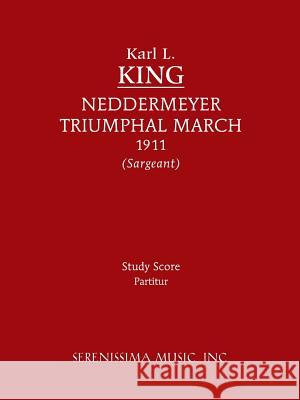Neddermeyer Triumphal March: Study Score » książka
Neddermeyer Triumphal March: Study Score
ISBN-13: 9781608740963 / Angielski / Miękka / 2013 / 26 str.
Karl Lawrence King (1891-1971) was born in Paintersville, Ohio, and ranks only behind Fillmore and Sousa as the foremost American march composer. King was a largely self-taught musician who learned the cornet early and soon was proficient enough to join the Thayer Military Band. In 1910 he moved to Columbus, Ohio and played baritone horn with the Neddermeyer Band, a professional band led by Fred Neddermeyer. He went on to play tuba in the Soldiers Home Band in Danville, Illinois, as well as in several circus bands, including Barnum and Bailey's, serving as leader of their band from 1917 to 1918. He learned to compose by studying scores, publishing his first composition at age 17 through Charles Barnhouse. Relations became somewhat strained with this publisher, which may have led to his use of the pseudonym Carl Lawrence and his decision to establish his own publishing company, the K.L. King Music House of Canton, Ohio, in 1919. In 1920 he moved to Fort Dodge, Iowa, as Director of the Fort Dodge Municipal Band, and continued his publishing from there. King was a prolific composer, writing over 300 works for band, including 188 marches. He composed mainly for larger bands up to 1940, then after that time primarily for school bands. The Neddermeyer Triumphal March was composed in 1911 as a tribute to his mentor, Fred Neddermeyer, and was published by Barnhouse. This new edition from Richard W. Sargeant Jr. retains King's original orchestration from the first edition (woodwinds, including E-flat and B-flat bass clarinet, SATB saxophones, brass, snare drum, cymbals, bass drum) in an easy-to-read format which is conveniently sized as either a study or performance score.
Karl Lawrence King (1891-1971) was born in Paintersville, Ohio, and ranks only behind Fillmore and Sousa as the foremost American march composer. King was a largely self-taught musician who learned the cornet early and soon was proficient enough to join the Thayer Military Band. In 1910 he moved to Columbus, Ohio and played baritone horn with the Neddermeyer Band, a professional band led by Fred Neddermeyer. He went on to play tuba in the Soldiers Home Band in Danville, Illinois, as well as in several circus bands, including Barnum and Baileys, serving as leader of their band from 1917 to 1918. He learned to compose by studying scores, publishing his first composition at age 17 through Charles Barnhouse. Relations became somewhat strained with this publisher, which may have led to his use of the pseudonym Carl Lawrence and his decision to establish his own publishing company, the K.L. King Music House of Canton, Ohio, in 1919. In 1920 he moved to Fort Dodge, Iowa, as Director of the Fort Dodge Municipal Band, and continued his publishing from there. King was a prolific composer, writing over 300 works for band, including 188 marches. He composed mainly for larger bands up to 1940, then after that time primarily for school bands. The Neddermeyer Triumphal March was composed in 1911 as a tribute to his mentor, Fred Neddermeyer, and was published by Barnhouse. This new edition from Richard W. Sargeant Jr. retains Kings original orchestration from the first edition (woodwinds, including E-flat and B-flat bass clarinet, SATB saxophones, brass, snare drum, cymbals, bass drum) in an easy-to-read format which is conveniently sized as either a study or performance score.











